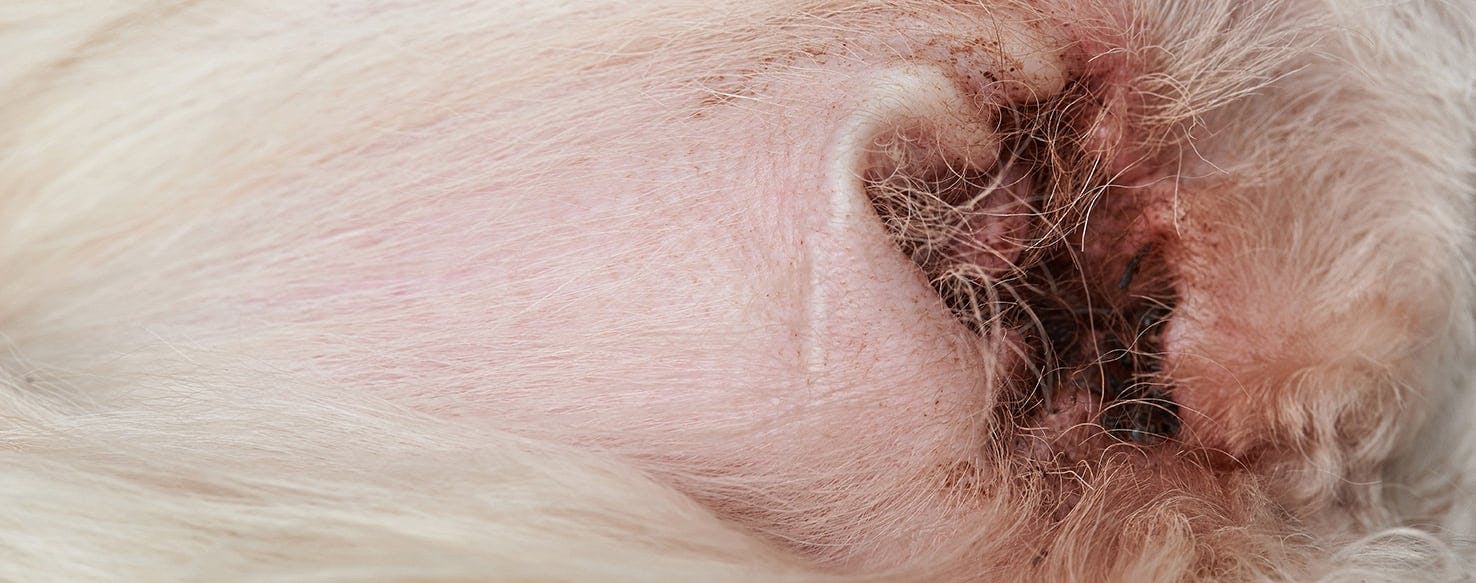Long time pet owners know that there are a number of bothersome conditions that can affect your cat and dog. One of the foremost among these is a pesky little parasite that likes to take up residence in the ears of your cat. These ear mites are highly aggravating for your poor feline and can lead to a host of other conditions.
While it’s fairly common knowledge that these pests can infect cats, if you have other pets, say a dog, in the household you may wonder whether they’re also at risk of contracting the condition.
As it turns out, those same annoying critters that take up residence in your cat’s ears can also wreak havoc on Fido. While ear mites are more common in felines, canines that come in contact with them are also susceptible.
Does My Dog Have Ear Mites?
Ear mites are microscopic parasites that feed off of the ear wax and buildup within your dog’s ear canal. While they don’t directly bite your dog, they do cause itching and irritation which can lead to scratching, inflammation, and infection. It may be difficult to spot ear mites, but with a few pointers we can make this aggravating condition more easily identifiable so that dog owners can get Fido the treatment he needs.
Symptoms
Outward symptoms of ear mites in your dog will begin with excess scratching of the ears and head shaking. Internally, your dog’s ear will appear dirty with black or waxy build up that resembles used coffee grounds in appearance. There may also be scabs or open, bleeding sores due to your dog’s nails.
Causes
Ear mites are parasites that are passed on from one infected animal to another. While cats are these critters’ preferred target, ear mites can and do transfer between species. Good thing for humans, ear mites don’t prefer to infest people and instead stick to our four-legged friends.
Diagnosis
Diagnosis of ear mites in your dog will begin with a thorough physical exam by your veterinarian. Your vet will take a small scraping from the inside of your dog’s ear canal which will be examined under a microscope. The presence of ear mites is easy to spot with these specialized magnifying tools.
How Do I Treat My Dog’s Ear Mites?
Treatment of ear mites in your dog will be a two part process and may involve additional procedures and medications, depending on the presence of any ear infection or other underlying conditions. First, your dog’s ears should be kept thoroughly clean using an anti-microbial solution. Since ear mites feed off of wax and debris, eliminating this will help starve the buggers out.
Next you will be prescribed a special solution to kill and repel any remaining mites. This will usually consist of drops or a wash solution and should be applied daily. It’s important to maintain a strict regimen and closely follow all veterinary protocols, as ear mites will take any opening to return with a vengeance. Your vet may also prescribe antibiotics, steroids or other medicines to treat infection or inflammation in severe cases.
How Are Ear Mites Similar in Dogs and Cats?
Both dogs and cats are affected by ear mites in similar ways. These tiny pests will use close contact to hop from one host to another and enter the ear canal, where they will feast on wax and buildup. Ear mites can cause a great deal of irritation and damage if left untreated, mostly from your dog or cat irritating the area with their paws or claws.
How Are Ear Mites Different in Dogs and Cats?
Although very similar, there are some differences between ear mites in dogs and cats. Ear mites prefer the ears of cats and will more readily and severely inspect them than the canines in your house. Ear mites in cats can cause more severe infections, more quickly, given the unprotected nature of the ear canal.
A typical case of ear mites in your dog will begin slowly. One day your dog may begin shaking his head excessively. You may inspect the ear and notice a little bit of black residue which can be mistaken for dirt. If ear mites are present, no amount of cleaning will fully clear up the issue and the dirt and buildup will continue as long as ear mites are still present. After a quick trip to the vet and some rigorous and meticulous cleaning on a set, daily schedule, your dog’s ear mites will clear up, leaving Fido healthy and happy with no long-term consequences.



